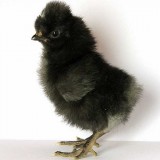
This picture is what happens when I forget to take a picture of our broody hens.
This past week three of our four hens decided to all get broody at once. And since we have only one nesting box they all crammed into the box as tight as passengers in economy class in what passes for air travel these days. Since it’s August and hot and humid, I began to worry that they would overheat.
Then I remembered a trick passed along by a UC David avian veterinarian at a conference I recently attended. He suggested giving broody hens a cold (out of the tap) bath. I gave this a try, giving each broody hen a 30 second dip in a shallow tub of water (just enough to get their derrieres wet). It worked immediately and they spent the rest of the day scratching, eating, drinking and running around.
But by the next day they were back in the nesting box. I spoke to Dr. Google who informed me that it sometimes takes more than one bath for this trick to work. After another 30 second dip in a cold bath they have not returned to the nesting box.
If you live in a cold climate I’d suggest drying them off after the bath.
Have you tried the cold bath technique? Did it work for you?





I’d heard about this method from a friend with chickens but decided I didn’t want to get my hens wet. Instead, I built an elevated pen in the upper corner of the run that has a separate source of water and a food dish. A broody hen goes in with water and food and four days later, a laying hen comes out. It might actually take a day or two or three for the hen to start laying again, but at least she isn’t trying to hang out in the nest box. I talked to my mom and it turned out that this was exactly the way my grandfather handled broody hens on their egg ranch. It’s just a different method for achieving the same end, which is to cool the internal temperature of the hen so that she stars ovulating again.
Ditto. I’ve got a Broody Time Out box as well, hung up in my coop with a wire mesh floor. Equal time in the box as time spent broody. It gets turned upside down and gets used as a plant fence in the garden to protect seedlings from the ladies.
The cold bath doesn’t work. At least not for my hens. I’ve tried it. Nor does frozen peas or ice packs in the nesting boxes. Tried those, too. The anti-broody coop will work. It can take 4 days. For some hens that does it. But for the breeds that love to be broody, it’ll only buy you a week or so. I have a FAQ about the broody hen with a photo of the anti-broody coop here: http://hencam.com/faq/the-broody-hen/ But it’s not anything fancy – a hand-me-down rabbit hutch.
I’m trying it on myself right now!
The baths didn’t work for my hens either, although I confess to giving up after about Day 7 of cool baths. The wire-bottomed cage is another option, although I think my hen was in it for about 3 weeks, so I don’t really think that worked either…the brood may have just run its course by that time. This last time it happened I let her sit on some fertilized eggs and hatch some chicks — THAT worked like a champ. She stopped brooding the day they hatched. Not practical for everyone, though.
We do the wire bottom cage (inside the run) for 5 days. It works every time. We have a couple of hens that go broody every year, so we just keep it handy.
I have tried the water method with different hens. My experience with broody breeds, like cochin and silkie, it doesn’t seem to be a long term solution. I prefer the broody coop method with airflow under the hen, very similar to what others mentioned. The longer the hen has been broody, the longer it takes to break them and get back to normal laying. If I notice the first day, it often only takes two or three days for the hen to snap out of it.
Our broody cage is just an old wire dog crate (minus the floor tray) propped up on bricks in the chicken run and with food and water. Worked in just a couple days, and we were glad not to even have to build anything special. We’re thinking of using it as a time out box for our bossiest hen, too—if we get her out of the mix we’re hoping to bring her back to a lower place in the pecking order so she won’t be so horrible to our younger ladies.
For the standard hens a broody coop works eventually. I’ve never tried the cold water dip-I might give it a go next time.
For the banties I have it’s really easy. No eggs=no setting. They might hang out for a half day in an eggless nest but not much longer. The only trick is keeping another hen from laying where they are. And finding them if they have a hidden nest.
Never tried a bath. Neat idea. I use a broody box, a birdcage I found and sanitized, with a spare beekeeping ventilated inner cover as a raised screen floor to get air under her. Works every time- I move her back with the flock once she stops bristling her feathers and screeching and starts cooing again. Takes 2 or 3 days average. I also put a nipple waterer on top of the cage so it doesn’t take up room inside and feed her once a day if she wants to eat. I used to use a dog crate but wanted to scale down the cleanup and since she’s broody, she doesn’t need much room- she just wants to sit there, or stand there, occasionally.
You joked about having a tiny cow. They really do exist. Dexters from Ireland. Super small and docile. Good for meat as well as milk even on really small plots of land.